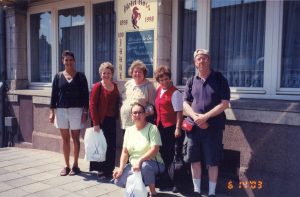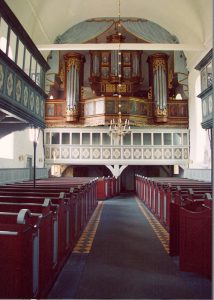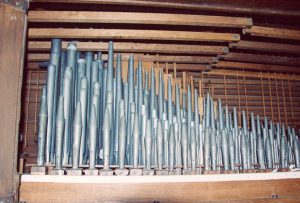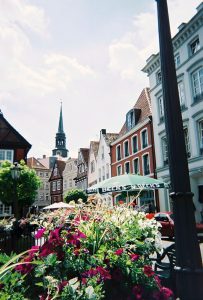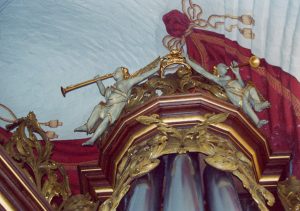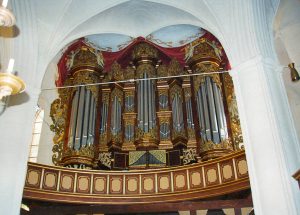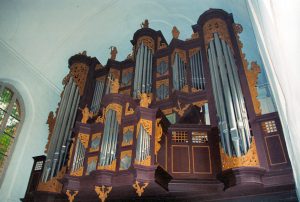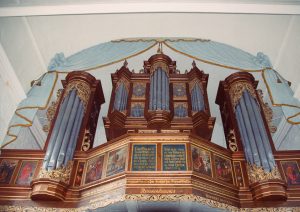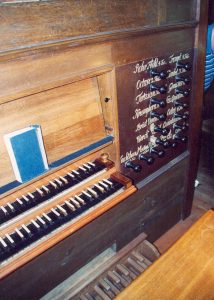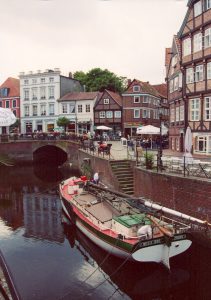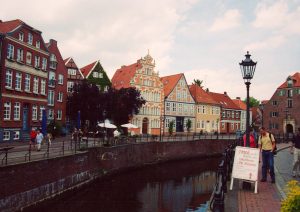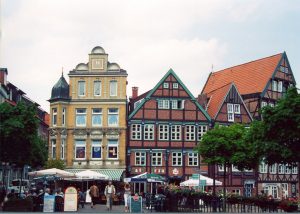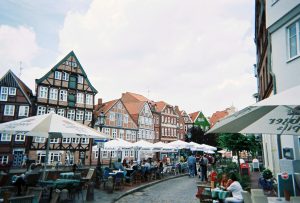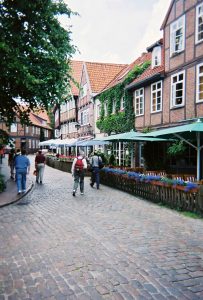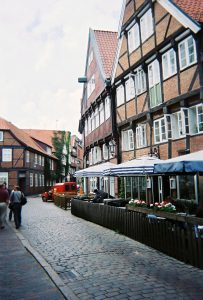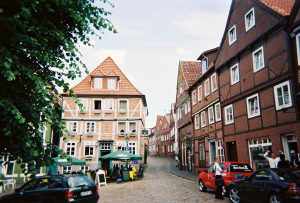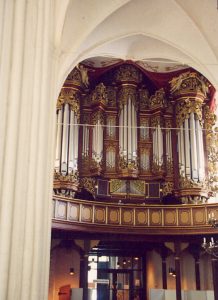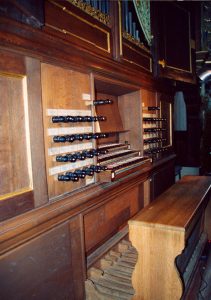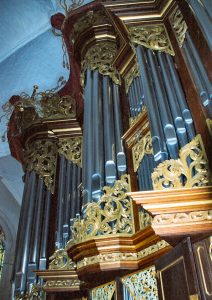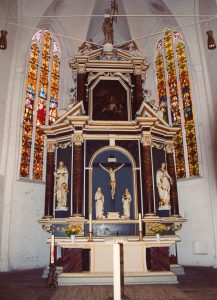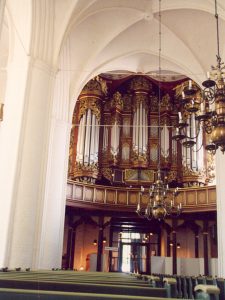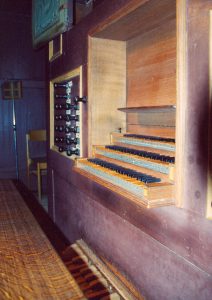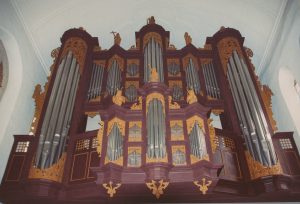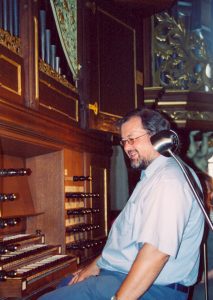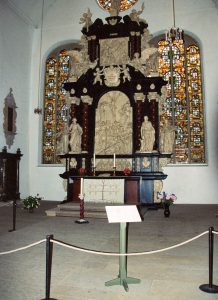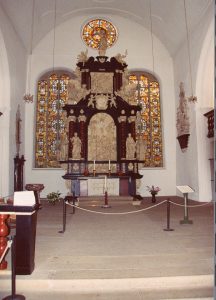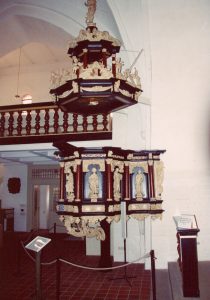Historic Organs of Germany
June 12, 2003
Steinkirchen and Stade
I must have been in high academic mode when I wrote this page in 2003. It’s way too long. If my turgid prose gets to be too much, just scroll way down to the bottom and look at the pictures. They’re not all mine, and they look good.
Early Thursday morning the group went in different directions, with the organists visiting more organs by Schnitger and the rest of the group staying in Hamburg for sight-seeing and shopping.
Those who chose to explore Hamburg had a delightful day. They began with a two-hour boat ride and cruise through the Alster and many of the city’s canals. Everyone who expected this venerable port city to be wholly industrial in appearance reported great surprise at the many beautiful residential areas, parks, and public places they passed on the cruise.
The cruise was followed by lunch at different restaurants, most of the group choosing to dine outdoors so as to enjoy the beautiful weather. After lunch visits to an antique mall, visits to museums, and shopping took up the remainder of the day. Thanks to Marilyn Hodges for the photo.
For the rest of us, though, the day was filled with activities of another sort, as we left on the bus for a trip to Steinkirchen and Stade.
Steinkirchen: St. Martin
The bus ride from Hamburg took us through small towns and villages, past farmland and acres of fruit trees, and even beside strawberry fields with “You pick ’em” signs. Martin Böcker, Artistic Director of the Stader Orgel Akademie, gave us a great introduction to the area in general, its history and its effect on the type of organs found there, and the background and history of this organ and church in particular.
The church itself is not large, and the Baroque altar is so large as to be almost overpowering in the room. The galleries running along the sides have small private entries, and though they might appear to be intrusive, they contribute to the ambient acoustic of the church.
Once again we were treated to a masterful demonstration of the organ. Beginning with the oldest stops, those pipes Schnitger re-used from the sixteenth-century organ by Hoyer. Herr Böcker improvised in a stylistically appropriate way for each sound of the organ. The sound of the Hoyer stops was very vocal—a broad vowel quality with clearly articulate speech characteristics.
The Schnitger additions were different in their color, but they once again formed a chorus that had the same impact as the ones we heard in Hamburg the day before. Though the room is small, and the chorus sounds of the same color, quality and impact, the total amount of sound in the room is big without being overpowering. The two (room and organ) are a perfect fit.
The flutes also had the broad colorful sounds that are almost diagnostic of this type of organ.
This time we heard the Nasat of the hauptwerk used in combination with the Prestant, a solo combination that also served homophonic textures well. The contrast between the Nasat of the Hauptwerk and the Quinte of the Brustwerk (a stop built some time after Schnitger by an anonymous builder) was obvious.
The reeds are very colorful, and none of them have the ugliness found in imitation Schnarrwerk I have heard before. The biggest surprise to me was the sound of the Hauptwerk Trompete, one of the original Schnitger stops on the organ. The color leaned toward that of a Krummhorn, though without some of the brightness of the real krummhorns of these instruments. Not that I would ever confuse the sound of this trumpet with that of a Krummhorn, it’s just a matter of finding a little bit of a “clarinetty” quality in the vowel of this stop. Really caught my ear, as did the sounds of the other reeds. Others noted that the pedal reeds seemed somewhat weak compared to the sound of the Manuarl chorus.
This time, when we had the chance to go to the consoleand play, we were prepared for the keyboard compass and the general appearance of the keydesk, but there were other elements that cought our attention. The Brustwerk is closer to the player in this small instrument than in the large organ of Hamburg’s Jacobikirche, of course, and we could get a good close look at the stop trundles of the Hauptwerk above the pipes of the Brust, and of the Hauptwerk rollers behind them.
Making inspections of this sort took second place to actually playing the instrument, and we once again enjoyed trying out our own improvisations and prepared pieces on this organ.
Stade: St. Wilhadi
For lunch, we moved on to Stade, where we enjoyed its picturesque houses and other buildings alongside the canals that have provided transportation in this area for centuries. As Herr Böcker had explained to us earlier, there is little or no stone in this area, so most construction—even the Medieval churches we had visited—were built of brick. Taking two hours for lunch gave us an opportunity to absorb the sights and sounds of the trip up to this point, and to talk to one another about our impressions of and reactions to the organs. Soon, though, we were eager to move on to St. Wilhadi.
As you can see from the photograph to the left, the church is built of brick, and as you approach it—from any direction—it doesn’t appear to be a very impressive structure. Parts of the building date from as early as the thirteenth century, but damages through the centuries caused several parts to be rebuilt.
We weren’t sure how long the walk to the church would take, and we arrived early for our appointment with Herr Böcker. That gave us time to look around the building and see how different this church appeared from the Martinikirche in Steinkirchen. The rather plain exterior didn’t prepare us for the splendor we found inside. As the oldest church in Stade, St. Wilhadi had more treasures than we had seen before in our short stay in Germany.
In the early eighteenth century, a fire started by lightning destroyed the organ completed (as a rebuild) by Schnitger in 1714. The replacement for that instrument was the existing organ built by Erasmus Bielfeldt in 1736. As Herr Böcker explained, Bielfeldt had been influenced by Droper, whose lineage as an organ builder brought many southern influences to this instrument. From details of the case in this photograph, we could easily see the more flamboyant decoration. Once again, Herr Böcker’s demonstration then allowed us to hear the differences as well.
The result of the Italian/Southern influence—as well as of a slightly later aesthetic—was obvious in the gentle sound of the principals. But the choruses were once again driven by the mixtures, not unexpected after the other instruments we had heard. The trumpet here had what I would describe as a “real” trumpet color, distinct from the sound of the Trompete in Steinkirchen.
Even though the flutes were less numerous than in the typical instrument of this region—another Italian influence—they were beautiful and colorful. Certainly not the dull sound found on many of the instruments I play regularly.
After the demonstration, we didn’t take much time to play the instrument. We wanted to move on to St. Cosmae and the first instrument completed by Schnitger.
Stade: St. Cosmae
Our demonstration here was shorter than the others, but we had time to hear the stops built by Huss and compare them to those built by Schnitger in the completion and later enlargement of this organ. Herr Böcker had to return to St. Wilhadi for a short service, so he left the key with us and we had the church to ourselves for as long as we wanted. It goes without saying that we all enjoyed this privilege to the best of our abilities!
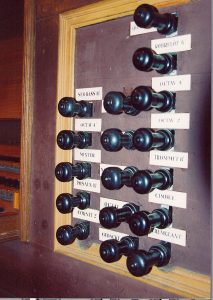 This was our last chance to both hear and play an instrument of this style, and we all felt the need to find out exactly how it felt to play the organ. To most of us the touch was heavy, and Herr Böcker returned in time to show us some aspects of manual technique that made things a little easier to handle. Even so, we still had a few things throw us curves: The stops knobs for the Rückpositiv were located behind us, actually built into the case there. The sound of the Brustwerk was once again quite prominent in the player’s ear, but light and delicate from the church, making it really necessary to check registrations with a listener down below. Though we had found the pedal reeds in Steinkirchen (and also in St. Wilhadi) to be weaker than we expected, the overall strength of the pedal division here meant that any thoughts we had about similarities had to be revised.
This was our last chance to both hear and play an instrument of this style, and we all felt the need to find out exactly how it felt to play the organ. To most of us the touch was heavy, and Herr Böcker returned in time to show us some aspects of manual technique that made things a little easier to handle. Even so, we still had a few things throw us curves: The stops knobs for the Rückpositiv were located behind us, actually built into the case there. The sound of the Brustwerk was once again quite prominent in the player’s ear, but light and delicate from the church, making it really necessary to check registrations with a listener down below. Though we had found the pedal reeds in Steinkirchen (and also in St. Wilhadi) to be weaker than we expected, the overall strength of the pedal division here meant that any thoughts we had about similarities had to be revised.
All in all, we had a wonderful “North German” day, from the ride through the area to the final note we played on the organ of St. Cosmae. Martin Böcker had been a most enjoyable host, and without him, the day would have been less meaningful. We continue to be grateful for his time and assistance to a group of travelers who had learned much from him in a single day.
After the return to Hamburg, we were left with only memories of the Schnitger organs we had heard, for the next day we set out for Lübeck, Berlin, and a new set of experiences altogether.
Journal Entry
June 12 Stade was truly charming: very “old world.” The architecture of the town buildings as well as the churches was fascinating to me, but what fascinated me the most today was the dialect spoken here. As a student of organ and of the German language, I got my first “real” exposure to the plattdeutsch, or flat german, dialect, which is commonly spoken in this region of Germany. It is, at first, rather hard to understand and read, becuase it seems to be a mixture of English sounding words, yet spelled in German! The dialect is actually a bridge between German and English, and is closely related to Dutch. The dialect appeared in written form on menus, gravestones, and on signs, and was spoken by waiters and shopkeepers. Truly fascinating for me, and a lot of fun to try and read and speak it!

